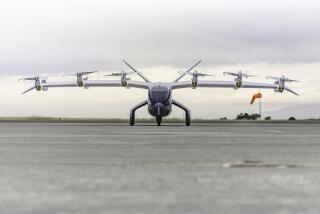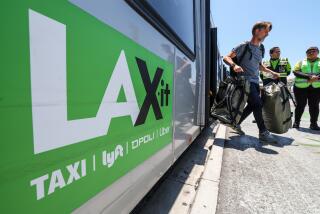Virgin America provokes fare wars at LAX
For years, JetBlue Airways Corp. turned up its nose at flying out of Los Angeles International Airport, saying that LAX was too big, too crowded and, well, that it just preferred to operate out of smaller hubs.
Then out of the blue last month, the low-cost carrier stunned LAX officials by asking for gates there. Moreover, it wanted them in Terminal 6 next to Virgin America, the airline started by eccentric British billionaire Richard Branson.
It was no surprise to industry observers. Branson is once again shaking up the industry with an airline that is offering low fares and unusual onboard amenities.
The repercussions have been particularly visible at LAX where the airline has heated up the kind of competition the airport hasn’t seen in recent memory.
LAX passengers flying to popular domestic destinations such as San Francisco and New York are enjoying some of the lowest fares in years despite record fuel prices.
“We’ve become a hotbed of competition,” said Paul Haney, the airport’s deputy executive director. “I don’t know if we could say that without Virgin America.”
Since Virgin America began flying out of LAX in August with fares as low as $44 one-way, competitors have been beefing up flights and lowering fares and even JetBlue has been prompted to enter the market.
Southwest, United and Alaska airlines, long LAX mainstays, added flights to routes served by Virgin America. And they either matched or lowered fares closer to that offered by the airline.
When Virgin America announced it would begin flying between LAX and Seattle, Alaska quickly responded by adding three more flights between the two cities.
The additional flights would begin in April, a month before Virgin America had planned to enter the Seattle market. Not to be outdone, Virgin America changed the start of the service, pushing it up to April and announced it would offer one-way $77 fares, or about half of the prevailing rate.
Forest Hills, N.Y.-based JetBlue, which has had its part in shaking up the industry with discount fares since it started flying in 2000, said last month that it would begin serving LAX passengers with four daily flights to New York and Boston beginning in May.
The sudden flurry of choices for flights to some of the more popular destinations has been a boon for LAX consumers, who are seeing fares as much as half of what they had been used to paying.
“It’s been awesome,” said Brandon Brown, a San Francisco State University student whose family lives in Westchester and was flying down from San Francisco on a Virgin America flight. “Sometimes it’s now cheaper for me to fly than drive.”
And analysts don’t expect much of a letdown in competition as Virgin America looks to expand at LAX.
The airline said that over time its operations at LAX would be “relatively equal in size” to its main hub in San Francisco where it has its headquarters.
“We’d love to grow there,” Virgin America Chief Executive David Cush said. “It’s a huge travel market.”
The airline said it was talking to LAX officials about expanding, including the possibility of moving from Terminal 6, where it has two gates to Terminal 3, where it would like to eventually have as many as six gates.
The airline currently operates 12 flights at LAX, flying to three cities: San Francisco, New York and Washington. That will grow to five cities by this summer. In all, the airline envisions flying to 30 cities within three years.
But some analysts questioned whether the airline could sustain the growth or even survive amid record fuel prices and a slowing economy that is expected to reduce air travel.
“It’s a tough environment,” said Ray Neidl, an aviation analyst with Calyon Securities.
Cush said that the airline didn’t expect to be profitable for two more years, taking longer than planned because of high fuel prices. But Cush said the airline was well positioned financially to weather any downturn.
“If we had started two years ago when fuel was half the cost we would have been able to reach profitability a lot faster,” Cush said, noting how regulators had twice killed plans to launch the airline because of concerns with foreign ownership.
The airline got approval to fly after Branson’s Virgin Group lowered its stake in the airline by half to 25%.
Virgin America is hoping that passengers will be drawn to not only its low fares but also to its amenities at a time when most airlines are slashing service to cut costs.
Trying to project the image of a hip airline, it has mood-lighting in the cabin and personal video screens at every seat with which passengers can order meals, watch on-demand movies and engage in an “in-flight chat room.”
But analysts have questioned whether such amenities can draw the more lucrative business traveler who typically flies major U.S. carriers such as United and American because of their frequent-flier programs.
Cush said the airline was looking at various marketing and other frequent-flier tie-ins with major airlines, a move that would appeal to business travelers like Scott Vigil, director of sales at Kensington Computer Products Group.
“I fly United and American because of all the frequent-flier miles I have with them,” the Carlsbad, Calif., resident said. But he added that a Virgin America tie-in with a major airline “would be exceptionally compelling.”
More to Read
Sign up for The Wild
We’ll help you find the best places to hike, bike and run, as well as the perfect silent spots for meditation and yoga.
You may occasionally receive promotional content from the Los Angeles Times.






